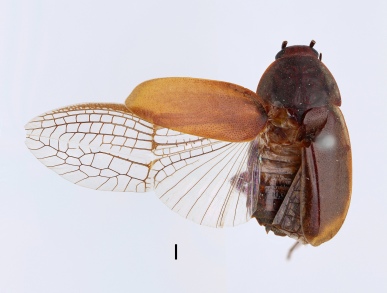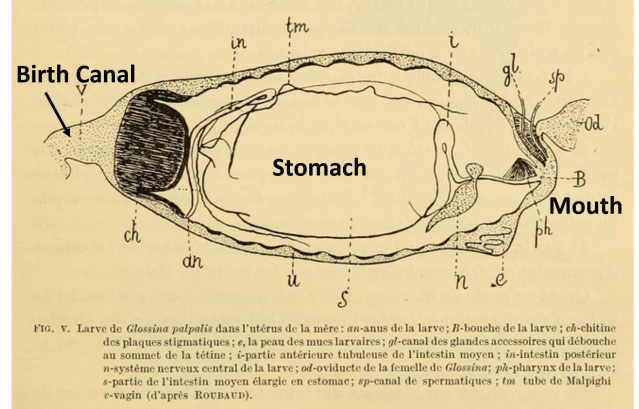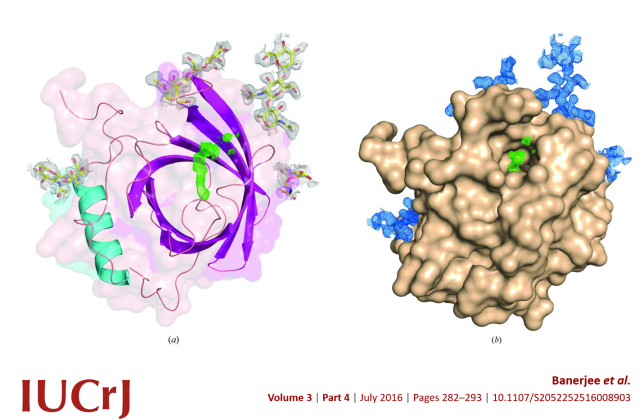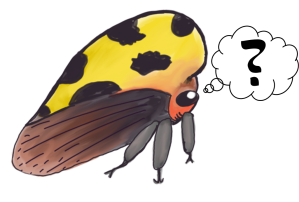Written by Joe Ballenger

Diploptera bicolor, a species closely related to D. punctata. Image Credit: Lund University Entomological Museum, via Flickr. License info: CC-BY-NC2.0
A number of articles circulating everywhere online are claiming that a new ‘superfood’ has been found in cockroaches, and although I’m happy popular culture is focusing on the fact cockroaches are good moms…they’re missing a far more important story.
To put this research into context, the Pacific Beetle Roach (Diploptera punctata) gives live birth and nourishes its young inside her body until they’re big enough to defend themselves. It’s an interesting evolutionary story, and one that’s kind of important. However, nobody has really seriously thought about using this species for food. People become allergic to cockroaches very easily. The Milk proteins secreted by these roaches also lack Methionine and Tryptophan…amino acids humans need for survival but which we can’t make.
However, this is a protein which does some pretty cool things…and could be used to design new drugs.
So let’s explore what’s really going on with cockroach milk.
How do cockroaches make milk?
Cockroaches don’t have nipples or udders, so you can’t really milk them. Cockroach milk production is very different than the lactation mammals do. The whole gestational process of live-bearing insects is very different, in fact.
Unfortunately, there aren’t any really great pictures or videos of Diploptera…but there are some really great diagrams of the Tse Tse‘s birthing process. We can use that, because it’s very similar.
When insects give live birth, it looks about what you’d expect. Here’s a video of the Tse Tse giving birth:
Internally, however, the process is very different. Mammals use a umbilical cord to transfer nutrients to their offspring. In the insect, there’s no placenta…or even no real direct connection. Here’s a cross-section of the maggot inside the Tse Tse mom’s uterus.

The Tse Tse maggot lays with it’s mouth facing the uterus, and the mother secretes a nutrient dense substance into the uterus. Unlike in humans where the developing baby takes up nutrients from the umbilical cord, the maggot eats the nutrient dense substance with it’s mouth and digests it with it’s stomach.
What were these scientists really researching?
So here’s where the tragedy of this terrible news reporting comes into focus…the scientists weren’t talking about human nutrition. They were taking pictures of individual proteins. Essentially, telling us what the milk proteins look like.
This technique is called X-ray crystallography, and it is extremely difficult.
X-ray crystallography
X-ray crystallography is science on ‘hard mode’.
First, biochemists have to get proteins to become crystals. To do this, they subject them to a huge variety of conditions…and it’s all guesswork. There’s no way to predict what conditions will cause proteins to crystallize. Some structures have taken decades of continuous work to solve, and we’ve had to straight-up shoot biomolecules into space to get it to happen.
After we get crystals, we take them to a particle collider and bombard them with high-power X-rays. The molecules scatter the light rays, and the scientists can use specialized equipment to see how this light scatters and complicated algorhythms to figure out what amino acids lay where in the protein.
Anything beyond the very general ‘how this works’ stuff is too complicated for most folks, even most scientists, to understand. The end results, however, are very cool.
The milk proteins of Diploptera form small crystals in physiological conditions, so the roaches were kind enough to take the hard part out of this exercise. Scientists love it when the hard part gets done for them by nature, so that makes stuff like this jump to the top of the list of things to do.
It’s easy…why wouldn’t we do it?

This protein, to biochemists, is actually really interesting. The protein provides most of the building materials the cockroaches need, although it is deficient in some amino acids. There’s a lot of sugars attached to it, which provides a part of the larva’s energy needs. The thing the scientists were interested in, however, are that blobby green thing in the middle.
That blobby green thing is a lipid, which cockroaches use for energy. The purple structure on the left side is a pocket which can hold general fatty substances like fatty acids or cholesterol. So the protein can be used to shuttle substances to the developing babies which wouldn’t normally be able to dissolve in the body fluids.
Stuff like this is really interesting to scientists because we can use it to figure out how to deliver drugs into the body, or develop new drugs based on proteins like this. Knowing how these sorts of pocket-forming proteins work also helps us understand how different processes happen, or are disrupted. The Zika vector, Aedes aegypti, uses a similar protein to keep its host from slapping it.
The Bottom Line
Pockets are just as important for biology, as they are for fashion. Insects use pocket-bearing proteins to shuttle things around which are hard to shuttle around…and we could potentially use similar proteins to do similar things in medicine.
So this protein is not important because it’s a superfood. It’s important because something similar could maybe carry drugs to cancer cells that could save your life one day.
There’s a big difference between that, and why this protein made the news.
Works Cited:
- Banerjee, S., Coussens, N. P., Gallat, F. X., Sathyanarayanan, N., Srikanth, J., Yagi, K. J., … & Ramaswamy, S. (2016). Structure of a heterogeneous, glycosylated, lipid-bound, in vivo-grown protein crystal at atomic resolution from the viviparous cockroach Diploptera punctata. IUCrJ, 3(4), 282-293.
-
Calvo, E., Mans, B. J., Ribeiro, J. M., & Andersen, J. F. (2009). Multifunctionality and mechanism of ligand binding in a mosquito antiinflammatory protein. Proceedings of the National Academy of Sciences, 106(10), 3728-3733.
- Holbrook, G. L., & Schal, C. (2004). Maternal investment affects offspring phenotypic plasticity in a viviparous cockroach. Proceedings of the National Academy of Sciences of the United States of America, 101(15), 5595-5597.
- Williford, A., Stay, B., & Bhattacharya, D. (2004). Evolution of a novel function: nutritive milk in the viviparous cockroach, Diploptera punctata. Evolution & development, 6(2), 67-77.


Pingback: sohkamyung comments on "Roach milk proteins fantastic food supplement"
Pingback: 1 – Cockroach milk is not the next superfood. It could be more important than that
This is a fantastic write up of connecting our science and the hype associated with it. I agree with your analysis of the purpose of our work, our conclusions and the great dreams. However, One this in this article is not true. The structure of the protein that we solved does have Methionine and Tryptophan in its sequence.. I paste the sequence below.
IAAILVANAKEPCPPENLQLPPRALVGK W YLRTTSPDIFKQVSNITEFYSAHGNDYYGTVTDYSPEYGLEAHRVNLTVSGSTLKFY M NDTHDYDSEYQILAVDKDYFIFYGHPPAAPSGLALIHYRQSCPKEDVIKRVKKNLKNVCLDYKYFGNDTSVPCHYVE
LikeLike
Thank you so much for clarifying this, I sincerely appreciate it.
LikeLike
“its” = possessive. “it’s” = it is.
“it’s mouth and digests it with it’s stomach” – no.
LikeLike
Pingback: Cockroach milkshake – Ree Kimberley